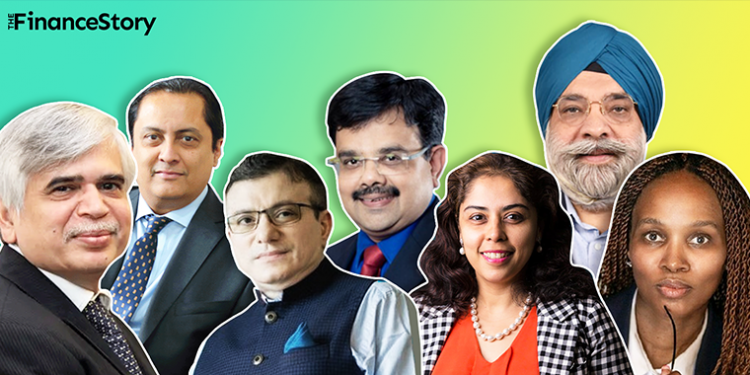Since 2021, almost all industries have been dealing with high employee turnover rates and it is not showing any signs of slowing down. This brings this common saying to light, ‘Are they leaving their companies or their managers?’
A Mckinsey report reveals that 35% of the respondent cited uncaring leaders as one of their top three reasons for leaving their organization.
Over the last few years, we at The Finance Story have interviewed several finance professionals who stayed with their respective organizations for more than a decade.
Did you know what their response was when asked about what kept them loyal to one company for that long? “We had great managers.”
The Finance Story spoke to Aseem Dhru – MD & CEO at SBFC Finance Ltd, Harinderjit Singh – Former Partner at PwC, Sangeeta Sumesh – Former CFO of Dun & Bradstreet, Robin Banerjee – President and CEO at Caprihans India Limited, Zimkita Mabindla – Director & Partner – KPMG, Richard Rekhy – KPMG India Partner, Sameer Chadha – CEO of KPMG Global Services.
Great leaders create leaders, not followers
A great example that conforms to the popular saying, ‘Great leaders do not create followers, they create leaders.’ can be found in CA Aseem Dhru’s career journey.
After qualifying as a chartered accountant he got job offers from two well-renowned foreign banks; Grindlays Bank and Citi Bank. A dream for many CAs you might say.
But as fate would have it, he eventually landed in HDFC in 1997, when the bank had just started out.
Aseem didn’t have a long-term goal of staying there, but it all changed when his managers gave him the huge responsibility of launching Retail Assets for the bank, that too at a young age.
When asked about some special memories at HDFC he said that the best part about the bank was CA Mr. Puri (previous MD at HDFC), as well as Chairman, Deepak Parekh.
According to Aseem, Mr. Puri could see the future with great certainty, and as an ideal mentor guided him as to what to do and what not to do, whenever it was needed.
That is how you differentiate between an average leader and a true leader, which Mr. Puri was in this case.
Even today, many employees hesitate to open up to their managers when they face some trouble regarding the task at hand, or are stuck somewhere.
Why?
Because they fear that they are going to get belittled by the manager or be called stupid for not knowing certain things. This only creates an environment of stress and fear, which is not the ideal working condition at all.
After 20 years of growth, CA Aseem decided to branch out into the entrepreneurial path, inspired by his senior at HDFC, Mr. Parekh.
South African Chartered Accountant Zimkita Mabindla’s pathway to Chartered Accountancy was filled with sharp turns and thorns. At one point she could see her dream of becoming a CA(SA) crashing.
But it was revived when she joined EY as a Junior Accountant (1998) while pursuing her Bachelor’s degree from UNISA.
While serving her articles at EY she was fortunate to be exposed to some of the most authentic leaders of the firm who made a significant impact on her life.
“I wanted to be a leader like them,” said Zimkita. And she did become the powerful leader that she is today, and continues to create more leaders by guiding young women professionals.
Leaders should create a safe workplace for employees
Trust is a very powerful word that drives this delicate relationship between managers and employees. Needless to say, it’s a two-way street wherein the employee puts his or her faith in the manager that he will take care of his career advancements.
As well as the manager should have faith in the employee that he or she would contribute his efforts and time for the betterment of the organization, and shouldn’t micromanage them.
When The Finance Story asked Harinderjit Singh, about why he stayed with PwC for 32 years, from the first day of his career to the last, he simply said “I had a lot of trust in my seniors that they will lead me to a good career in the firm.”
In fact, he became a partner in 1998.
Leadership lessons and modern methodologies coupled with the opportunity of working in a variety of challenging roles, and people friendly environment were what kept him in PwC for that long.
The importance of humility in leadership
In an article titled Why Employees Stay by Harvard Business Review, employee turnover, and its cause were getting discussed.
One of the paragraphs read, “However, since the values of people are not the same, what is right to the manager is often wrong for the employee. If we were to write a Platinum Rule, we should say, “Do unto others as they would have you do unto them.” This rule has obvious value for a manager who seeks to reinforce right reasons for staying, at various value levels, and to avoid reinforcing wrong reasons.”
While most managers may have a high IQ (Intelligence Quotient), when it comes to employee management, high EQ is required.
What is EQ (Emotional Quotient)? It is the ability to deal with others.
“Most of us ‘do not have the sensitivity to handle others’ viewpoints,” Robin says.
It took Robin two decades to become a CFO, but the wait was worth it though, as under the guidance of some great managers and leaders, and with the right experience he became the best version of himself.
He moved abroad and progressed to several leadership positions: from CFO & CEO at Arcelor Mittal Steel in Germany to Executive Director in major Indian entities.
After spending all these years in the shoes of a leader he claims that the two most important aspects that a leader should have are Humility and Kindness.
“Modesty helps to gain respect…and bashfulness attracts negativity.” He concludes.
Yes, Humility and Modesty are two of the golden qualities that most employees first look for in a leader when they consider joining a new company, and not the high status or an attractive salary package quoted by the latter.
Richard Rekhy’s professional journey has been one of excitement. He was fortunate to have worked for some of great companies and high-quality people.
Richard started his career in 1983 at a mid-sized firm. Over the years he developed entrepreneurial abilities and later moved to a larger firm where he transformed into a leader. He eventually became the CEO at KPMG.
“One quality that helped me sail through was humility and my ability to connect with my team and understand their behavior and their challenges.” He said.
This was imbibed in him by his former high-quality managers, that reacted the same way as him whenever Richard would come across a difficult situation at work.
“Humility is key as a leader. Success is always ephemeral—here today, gone tomorrow. So, people should remember you more for the person you are rather than the title you hold.” said Sameer Chadha when asked about leadership.
As the CEO of KPMG Global Services (KGS), a 12,000-colleague-strong organization he is constantly being watched and emulated. He is the ‘Chief Culture Officer’ and has inculcated a culture of transparency and trust to encourage people to say what is on their minds.
Leaders must be adaptive: One size doesn’t fit all
A leader is only as successful as the team members. They are the contributing factor to your success.
Gone are the days when one leadership style would suit every one of your team members.
In her previous role as a CFO, Sangeeta Sumesh had to manage her team in such a way that she could meet the deadlines.
One of her team members was prompt, and she did not have to go and remind him every hour to complete his tasks. Whereas the other team member was the polar opposite and needed constant reminders on his task.
“You cannot expect your team members to adapt to your working style anymore,” concludes Sangeeta.
As a leader, your role is to bring out the best in your team, but it cannot be achieved with the “One size fits all” mindset.
It’s time the leaders realize that each of their team members is different in nature with unique skill sets.
Wrapping up …
You can either grow a banyan tree or a bonsai tree. In a bonsai tree, the roots don’t go too deep and are moved from one pot to another frequently.
Whereas when you grow a banyan tree you make sure that the roots grow deeper, by providing the best quality of soil and watering it every day. In this case, let the leader be the gardener and the employee the bonsai tree.
The leader has to nurture the employee if he or she wants to get the best outcome.














